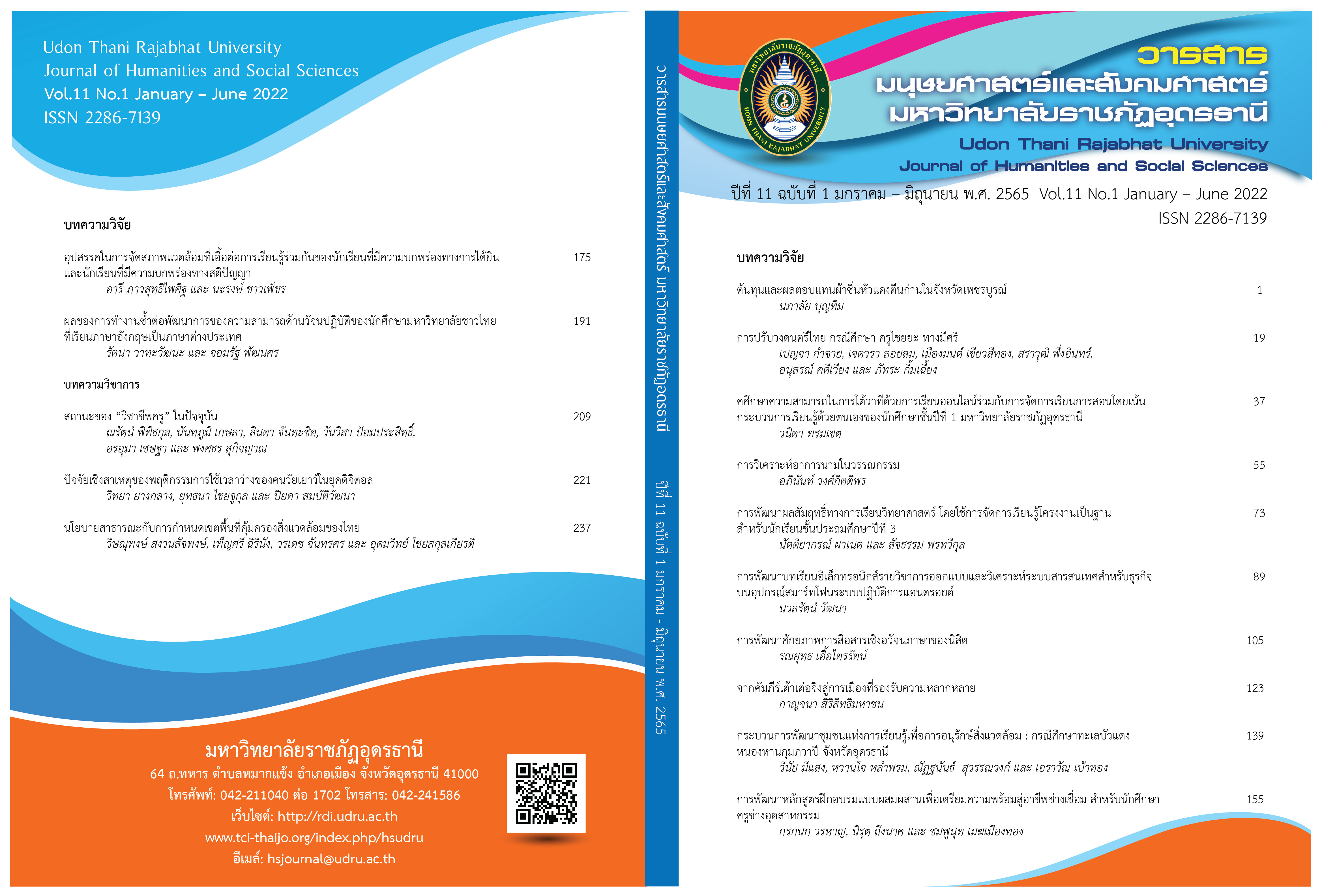ปัจจัยเชิงสาเหตุของพฤติกรรมการใช้เวลาว่างของคนวัยเยาว์ในยุคดิจิตอล
Main Article Content
บทคัดย่อ
พฤติกรรมการใช้เวลาว่างเป็นสิ่งสำคัญที่บ่งชี้ถึงคุณภาพของเยาวชน หากเยาวชนแสดงพฤติกรรมการเวลาว่างที่ดี ย่อมเกิดผลดีต่อตนเอง และส่งผลไปถึงการพัฒนาประเทศชาติให้เจริญก้าวหน้าในอนาคต จากการศึกษางานวิจัยทั้งในประเทศและต่างประเทศพบว่ามีปัจจัยที่สำคัญ 5 ปัจจัย ซึ่งส่งผลต่อการพัฒนาพฤติกรรมการใช้เวลาว่างของเยาวชน ได้แก่
1) ปฏิสัมพันธ์ทางสังคม เป็นการติดต่อสื่อสารเพื่อให้ได้รับความรู้ แนวคิด ความช่วยเหลือด้านการทำกิจกรรมใช้เวลาว่างจากบุคคลรอบข้าง 2) การตระหนักรู้กิจกรรมการใช้เวลาว่าง คือ การเห็นความสำคัญ ประโยชน์ที่ได้จากการทำกิจกรรมการใช้เวลาว่าง 3) การตระหนักรู้ตนเองต่อการใช้เวลาว่าง คือ การรับรู้เข้าใจเกี่ยวกับตนเองด้านการทำกิจกรรมการใช้เวลาว่าง 4) ทักษะการใช้เวลาว่าง คือ ความสามารถ ความชำนาญ ซึ่งช่วยส่งเสริมการทำกิจกรรมการใช้เวลาว่างให้มีประสิทธิภาพ ซึ่งปัจจัยต่างๆ ทั้ง 4 ปัจจัยนี้จะส่งผลไปยังปัจจัยที่ 5 คือการตัดสินใจเลือกกิจกรรม ซึ่งเป็นกระบวนการรวมรวบข้อมูล สร้างทางเลือก เปรียบเทียบทางเลือก และใช้เหตุผล เพื่อเลือกกิจกรรมให้เหมาะสมและถูกต้อง และการเลือกกิจกรรมจะนำไปสู่การแสดงพฤติกรรมการใช้เวลาว่างของเยาวชน ดังนั้นควรมีการศึกษาความสัมพันธ์ของตัวแปรต่างๆ เพื่อใช้ในการพัฒนาพฤติกรรมการใช้เวลาว่างของเยาวชนให้เกิดประสิทธิภาพสูงสุด
Article Details
เอกสารอ้างอิง
กระทรวงศึกษาธิการ. (2563). สภาวการณ์การจัดการเรียนรู้เชิงพื้นที่ในบริบทประเทศไทย. สํานักคณะกรรมการศึกษาขั้นพื้นฐานกระทรวงศึกษาธิการ, กรุงเทพฯ: โรงพิมพ์ชุมนุมสหกรณ์การเกษตรแห่งประเทศไทย จํากัด.
ชวิตรา ตันติมาลา. (2560). การสร้างอัตลักษณ์ของตลาดนัดภายในมหาวิทยาลัยของรัฐเขตกรุงเทพมหานคร. วิทยานิพนธ์ปริญญาปรัชญาดุษฎีบัณฑิต สาขาการวิจัยพฤติกรรมศาสตร์ประยุกต์ มหาวิทยาลัยศรีนครินทรวิโรฒ.
ปัญจนาฏ วรวัฒนชัย. (2563). พฤติกรรมที่เป็นปัญหาของสังคม. วารสารสารสนเทศ, 19(2), 1-16.
วิพงษ์ชัย ร้องขันแก้ว, อุษากร พันธุ์วานิช, มยุรี ศุภวิบูลย์ และ สุวิมล ตั้งสัจจพจน์. (2557). การพัฒนาโปรแกรมการศึกษาการใช้เวลาว่างสำหรับเด็กชั้นประถมศึกษาตอนปลายในสถานสงเคราะห์. วารสารคณะพลศึกษา, 17(1), 67-78.
ศักดิภัทร์ เฉลิมพุฒิพงศ์. (2554). การศึกษาการใช้เวลาว่างเพื่อการส่งเสริมคุณภาพชีวิต. วารสารคณะพลศึกษา, 14(2), 10-21.
สำนักงบประมาณ. (2562). งบประมาณโดยสังเขปประจำปีงบประมาณ พ.ศ. 2562. กรุงเทพฯ: สำนักนายกรัฐมนตรี.
สำนักงานสถิติแห่งชาติ. (2562). การใช้เวลาว่างของเยาวชน พ.ศ. 2562. กรุงเทพฯ: สำนักงานสถิติแห่งชาติ.
อารีรัตน์ สูงสมสกุล. (2557). รูปแบบการเข้าร่วมการใช้เวลาว่างของประชาชนในจังหวัดในภาคตะวันออกเฉียงเหนือ. วิทยานิพนธ์ปริญญาวิทยาศาสตรมหาบัณฑิต สาขาวิชานันทนาการ มหาวิทยาลัยเกษตรศาสตร์.
Bandura, A. (1986). Social foundations of thought and action: A social cognitive theory. Englewood Cliffs: Prentice-Hall.
Byrne, T. (2006). Free-time and leisure needs of young people living in disadvantaged communities. Dublin: Combat Poverty Agency.
Caldwell, L. L., & Witt, P. A. (2011). Leisure, recreation, and play from a developmental context. New directions for youth development, 2011(130), 13-27.
Dattilo, J. (2011). Facilitation Techniques in Therapeutic Recreation. Pennsylvania: Venture Publishing.
Deci, E. L., & Ryan, R. M. (2000). The “what” and “why” of goal pursuits: Human needs and the self-determination of behavior. Psychological Inquiry, 11, 227-268.
Fawcett, L. M. (2007). School's Out: Adolescent Leisure Time Activities, Inuences and Consequences. Australia: Faculty of Computing, Health and Science, Edith Cowan University.
Finn, P. R. (2006). An evaluation of the effects of a leisure education Curriculum. Philosophy in Public College of Health and Public Affairs, University of Central Florida Orlando, USA.
Henderson, A. (2017). Context and dialogue in research on women and leisure. Journal of Leisure Research, 34(3), 253-271.
Hutchinson, S. (2012). Leisure Education: A New Goal for An Old Idea Whose Time Has Come Pedagogía Social. Revista Interuniversitaria, 19, 127-139.
Kelly, J. R. (1987). Freedom to be: A new sociology of leisure. State College, PA: Venture Publishing.
Kraus, R. (2001). Recreation and Leisure in Modern Society. (6th ed.). Sudbury, MA: Jones & Bartlett.
Lin, T. C. (2011). Leisure activities’ selection and motivation. International Journal of Academic Research in Business and Social Sciences, 1(3), 308.
Mannell, R. C., & Kleiber, D. A. (1997). A social psychology of leisure. State College, PA: Venture.
McGrew, A. G., & Wilson M. J. (1982). Decision Making: Approaches and Analysis. Manchester, UK: Manchester University Press.
McKay, C. (2012). The psychological benefits of participation in leisure pursuits for adolescents. New Hampshire: University of New Hampshire.
Mundy, J. (1998). Leisure education: Theory and practice. Champaign, IL: Sagamore.
Oppenheim, A. N. (1979). Questionnaire design and attitude measurement (2nd ed.). New York: Basic Book.
Pesavento, L., & Ashton, C. (2011). Leisure education in the schools: Promoting healthy lifestyles for all children and youth. San Diego, CA: American Association for Physical Activity and Recreation (AAPAR).
Powrie, B., Kolehmainen, N., Turpin, M., Ziviani, J., & Copley, J. (2015). The meaning of leisure for children and young people with physical disabilities: a systematic evidence synthesis. Developmental Medicine & Child Neurology, 57(11), 993-1010.
Romain, R., Royer, C., Auger, D., & Adjizian, J. M. (2016). Development of adolescents' leisure interests and social involvement. Annals of Leisure Research, 19(1), 1-15.
Stumbo, N. J. & Peterson, C. A. (2009). Therapeutic recreation program design: Principles and procedures. (5th ed.). San Francisco, CA: Paerson Benjamin Cummings.
Thorlindsson, T. & Gunnar, B, J. (2006). Peer groups and substance use: examining the direct and interactive effect of leisure activity. Adolescence, 41(162), 321-339.
Voss, J. (1967). The definition of leisure. Journal of Economic issues, 1(1-2), 91-106.
Zeijl, E., du Bois-Reymond, M., & Te Poel, Y. (2001). Young Adolescents’ Leisure Patterns. Society and Leisure, 24(2), 379-402.


